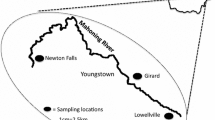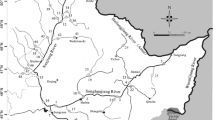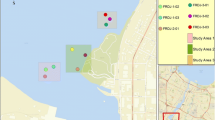Abstract
The sources of polycyclic aromatic hydrocarbons (PAHs) and sources of water that deliver PAHs to an investigated river were apportioned using an end-member mixing approach. The identification of sources and tracers was based on bounding the samples by end-member sources on the mixing diagram using coordinates of source tracer concentrations. The sums of PAHs with the same molecular weight were used as PAH source tracers, and the dissolved organic carbon to base cations ratio was used as a tracer for water sources. The source contributions were evaluated by solving systems of linear equations. Most of the water samples were bound by a triangle formed by wood combustion, oil-fired boilers, and aluminum smelters in the mixing space defined by the concentrations of the principal mass 178 and 228 PAHs. There were notable seasonal variations in the PAH source contributions at each sampling site due to different contributions of groundwater, surface flow, and interflow to stream water. The differences in the PAH source contributions among sites were due to both different proportions of the flow components and different positions of the sites relative to the emission sources. Most of the bottom sediment samples were bound by a triangle formed by the same sources, but in the mixing space defined by the principal mass 252 and 276 PAHs. There were no spatial or temporal differences in the PAH source proportions among the samples because the PAH composition of the bottom sediments at each location represents the time- and space-weighted average of all the sediment loads from upstream.







Similar content being viewed by others
References
Bayona JM, Casellas M, Fernandez P, Solanas AM, Albaiges J (1994) Sources and seasonal variability of mutagenic agents in the Barcelona city aerosol. Chemosphere 29(3):441–450
Behymer TD, Hites RA (1985) Photolysis of polycyclic aromatic hydrocarbons absorbed on simulated atmospheric particles. Environ Sci Technol 19:1004–1006
Belykh LI (2009) Distribution of polycyclic aromatic hydrocarbons in the soil-plant system. Eurasian Soil Sci 9:1005–1011
Belykh LI, Malykh YuV, Penzina EE, Smagunova AN (2002) Sources of atmosphere pollution by polycyclic aromatic hydrocarbons in industrial Transbaikalia. Atmos Ocean Opt 10:944–948 (In Russian)
Bildeman TF, Falconer RL (1999) Enantiomer ratios for apportioning two sources of chiral compounds. Environ Sci Technol 33:2299–2301
Bouloubassi I, Saliot A (1991) Composition and sources of dissolved and particulate PAH in surface waters from the Rhone delta (NW Mediterranean). Mar Pollut Bull 22(12):588–594
Brown FS, Baedecker MJ, Nissenbaum A, Kaplan IR (1972) Early diagenesis in a reducing fjord, Saanich Inlet, British Columbia—III. Changes in organic constituents of sediment. Geochim Cosmochim Acta 36:1185–1203
Callén MS, de la Cruz MT, López JM, Mastral AM (2011) PAH in airborne particulate matter. Carcinogenic character of PM10 samples and assessment of the energy generation impact. Fuel Process Technol 92:176–182
Chan Y, Hawas O, Hawker D, Vowles P, Cohen DD, Stelcer E, Simpson R, Golding G, Christensen E (2011) Using multiple type composition data and wind data in PMF analysis to apportion and locate sources of air pollutants. Atmos Environ 45:439–449
Chen BL, Xuan XD, Zhu LZ, Wang J, Gao YZ, Yang K, Shen XY, Lou BF (2004) Distributions of polycyclic aromatic hydrocarbons in surface waters, sediments and soils of Hangzhou City, China. Water Res 38:3558–3568
Chen HY, Teng YG, Wang JS (2012) Source apportionment of polycyclic aromatic hydrocarbons (PAHs) in surface sediments of the Rizhao coastal area (China) using diagnostic ratios and factor analysis with nonnegative constraints. Sci Total Environ 414:293–300
Choi SD (2014) Time trends in the levels and patterns of polycyclic aromatic hydrocarbons (PAHs) in pine bark, litter, and soil after a forest fire. Sci Total Environ 470:1441–1449
Christophersen N, Hooper RP (1992) Multivariate analysis of stream water chemical data: the use of principal component analysis for the end-member mixing problem. Water Resour Res 28:99–107
Cousins IT, Gevao B, Jones KC (1999) Measuring and modeling the vertical distribution of semi-volatile organic compounds in soils. I: PCB and PAHs soils care data. Chemosphere 39(14):2507–2518
Daub J, Forster J, Herrmann R, Robien A, Striebel T (1994) Chemodynamics of trace pollutants during snowmelt on roof and street surfaces. Water Sci Technol 30(1):73–85
Demir S, Saral A (2011) A new modification to the chemical mass balance receptor model for volatile organic compound source apportionment. Clean Soil Air Water 39(10):891–899
DiBlasi CJ, Li H, Davis AP, Ghosh U (2009) Removal and fate of polycyclic aromatic hydrocarbon pollutants in an urban stormwater bioretention facility. Environ Sci Technol 43(2):494–502
Dickhut RM, Canuel EA, Gustafson KE, Liu K, Arzayus KM, Walker SE, Edgecombe G, Gaylor MO, Macdonald EH (2000) Automotive sources of carcinogenic polycyclic aromatic hydrocarbons associated with particulate matter in the Chesapeake Bay region. Environ Sci Technol 34:4635–4640
Dong R, Lin Y (2004) Characterization and distribution of polycyclic aromatic hydrocarbon contaminations in surface sediment and water from Gao-ping River, Taiwan. Water Res 38:1733–1744
Dordevic D, Petrovic S, Relic D, Mihajlidi-Zilec A (2013) Applying receptor models UNMIX and PMF on real data set of elements in PM for sources evaluation of the sea coastal side region (Southeast Adriatic Sea). Atmos Meas Tech Discuss 6:4941–4969
Fernandes MB, Sicre M-A, Boireau A, Tronczynski J (1997) Polyaromatic hydrocarbon (PAH) distributions in the Seine River and its estuary. Mar Pollut Bull 34(11):857–867
Fernandez P, Grifoll M, Fernandez P, Bayona JM, Albaiges J (1992) Bioassay-directed chemical analysis of genotoxic components in coastal sediments. Environ Sci Technol 26:817–829
Galarneau E (2008) Source specificity and atmospheric processing of airborne PAHs: implications for source apportionment. Atmos Environ 42:8139–8149
Gorshkov A, Marinaite I (2002) Investigation of PAH in atmospheric aerosols and precipitation’s of east Siberia. NATO Sci Ser IV Earth Environ Sci 16:203–208
Gschwend PM, Hites RA (1981) Fluxes of polycyclic aromatic hydrocarbons to marine and lacustrine sediments in the northeastern United States. Geochim Cosmochim Acta 45:2359–2367
Guggenburger G, Pichler M, Hartmann R, Zech W (1996) Polycyclic aromatic hydrocarbons in different forest soils: mineral horizons. Z Planzenernahr Bodenkd 159:565–573
Guo W, He MC, Yang ZF, Zhang HY, Lin CY, Tian ZJ (2013) The distribution, sources and toxity risks of polycyclic aromatic hydrocarbons and n-alkanes in riverine and estuarine core sediments from Daliao River watershed. Environ Earth Sci 68(7):2015–2024
Guthrie EA, Pfaender FK (1998) Reduced pyrene bioavailability in microbially active soils. Environ Sci Technol 32:501–508
Harrison RM, Smith DJT, Luhana L (1996) Source apportionment of atmospheric polycyclic aromatic hydrocarbons collected from an urban location in Birmingham, UK. Environ Sci Technol 30:825–832
Henry RC (2003) Multivariate receptor modeling by N-dimensional edge detection. Chemom Intell Lab 65:179–189
Hooper RP, Christophersen N, Peters NE (1990) Modelling streamwater chemistry as a mixture of soilwater end-members—an application to the Panola mountain catchment, Georgia, U.S.A. J Hydrol 116:321–343
Hu NJ, Huang P, Liu JH, Shi XF, Ma DY, Liu Y (2013) Source apportionment of polycyclic aromatic hydrocarbons in surface sediments of Bohai Sea, China. Environ Sci Pollut Res 20:1031–1040
Hu NJ, Huang P, Liu JH, Shi XF, Ma DY, Shi X, Mao J, Liu Y (2014) Characterization and source apportionment of polycyclic aromatic hydrocarbons (PAHs) in sediments in the Yellow River Estuary, China. Environ Earth Sci 71:873–883
Jones KC, Stratford JA, Tidridge P, Waterhouse KS, Johnston AE (1989) Polynuclear aromatic hydrocarbons in an agricultural soil: long-term changes in profile distribution. Environ Pollut 56:337–351
Karthe D, Chalov S, Borchardt D (2015) Water resources and their management in central Asia in the early twenty first century: status, challenges and future prospects. Environ Earth Sci 73:487–499. doi:10.1007/s12665-014-3789-1
Kastner M, Breuer-Jammali M, Mahro B (1995) Enumeration and characterization of the soil microflora from hydrocarbon-contaminated soil sites able to mineralize polycyclic aromatic hydrocarbons (PAH). Appl Microbiol Biotechnol 41:267–273
Kennedy VC, Kendall C, Zellweger GW, Wyerman TA, Avanzino RJ (1986) Determination of the components of stormflow using water chemistry and environmental isotopes, Mattole River basin, California. J Hydrol 84:107–140. doi:10.1016/0022-1694(86)90047-8
Lai ICh, Chang YCh, Lee ChL, Chiou GY, Huang HCh (2013) Source identification and characterization of polycyclic aromatic hydrocarbons along the southwestern coastal of Taiwan—with a GMDH approach. J Environ Manag 115:60–68
Larsen RK, Baker JE (2003) Source apportionment of polycyclic aromatic hydrocarbons in the urban atmosphere: a comparison of three methods. Environ Sci Technol 37:1873–1881
Lee CL, Kuo LJ, Wang HL, Hsieh PC (2003) Effects of ionic strength on the binding of phenanthrene and pyrene to humic substances: three-stage variation model. Water Res 37:4250–4258
Liang J, Ma G, Fang H, Chen L, Christie P (2011) Polycyclic aromatic hydrocarbon concentrations in urban soils representing different land use categories in Shanghai. Environ Earth Sci 62:33–42
Liu F, Williams M, Caine N (2004) Source waters and flow paths in a seasonally snow-covered catchment, Colorado Front Range, USA. Water Resour Res 40:W09401. doi:10.29/2004WR003076
Liu X, Zhang G, Jones KC, Li XD, Peng XZ, Qi SH (2005) Compositional fractionation of polycyclic aromatic hydrocarbons (PAHs) in mosses (Hypnum plumaeformae WILS.) from the northern slope of Nanling Mountains, South China. Atmos Environ 39(30):5490–5499
Liu Y, Chen L, Huang Q, Li W, Tang Y, Zhao J (2009) Source apportionment of polycyclic aromatic hydrocarbons (PAHs) in surface sediments of the Huangpu River, Shanghai, China. Sci Total Environ 407:2931–2938
Luo X, Mai B, Yang Q, Fu J, Sheng G, Wang Z (2004) Polycyclic aromatic hydrocarbons (PAHs) and organochlorine pesticides in water columns from the Pearl River and the Macao harbor in the Pearl River delta in South china. Mar Pollut Bull 48:1102–1115
Malik A, Verma P, Singh AK, Singh KP (2011) Distribution of polycyclic aromatic hydrocarbons in water and bed sediments of the Gomti River, India. Environ Monit Assess 172:529–545
Menzie CA, Hoeppner SS, Cura JJ, Freshman JS, Lafrey EN (2002) Urban and suburban storm water runoff and polycyclic aromatic hydrocarbons (PAHs) to Massachusetts estuarine and coastal environments. Estuaries 25(2):165–176
Meyer T, Lei YD, Wania F (2011) Transport of polycyclic aromatic hydrocarbons and pesticides during snowmelt within an urban watershed. Water Res 45:1147–1156
Montelay-Massei A, Garban B, Tiphagne-larcher K, Chevreuil M, Ollivon D (2006) Mass balance for polycyclic aromatic hydrocarbons in the urban watershed of Le Havre (France): transport and fate of PAHs from the atmosphere to the outlet. Water Res 40:1995–2006
Ngabe B, Bidleman TF, Scott GI (2000) Polycyclic aromatic hydrocarbons in storm runoff from urban and coastal South Carolina. Sci Total Environ 255:1–9
Nganje TN, Edet AE, Ibok UJ, Ukpabio EJ, Ibe KA, Neji P (2012) Polycyclic aromatic hydrocarbons in surface water and soil in the vicinity of fuel-oil spillage from a tank farm distribution facility, EsukUtan, Calabar Municipality, Nigeria. Environ Earth Sci 67:81–90
Ngo VV, Michel J, Gujisaite V, Latifi A, Simmonot M-O (2014) Parameters describing nonequilibrium transport of polycyclic aromatic hydrocarbons through contaminated soil columns: estimability analisys, correlation, and optimization. J Contam Hydrol 158:93–109
Oros DR, Ross JRM, Spies RB, Mumley T (2007) Polycyclic aromatic hydrocarbon (PAH) contamination in San Francisco Bay: a 10-year retrospective of monitoring in an urbanized estuary. Environ Res 105:101–118
Paatero P (1997) Least squares formulation of robust nonnegative factor analysis. Chemom Intell Lab 37:23–35
Pergal MM, Relic D, Tesic ZL, Popovic AR (2014) Leaching of polycyclic aromatic hydrocarbons from power plant lignite ash—influence of parameters important for environmental pollution. Environ Sci Pollut Res 21:3435–3442
Prokes R, Vrana B, Komprdova K, Klanova J (2014) Annual dynamics of persistent organic pollutants in various aquatic matrices: a case study in the Morava River in Zlin district, Czech Republic. J Soils Sediments 14:1738–1752
Ravindra K, Sokhi R, Van Grieken R (2008) Atmospheric polycyclic aromatic hydrocarbons: source attribution, emission factors and regulation. Atmos Environ 42:2895–2921
Raza M, Zakaria MP, Hashim NR, Yim UH, Kannan N, Ha SY (2013) Composition and source identification of polycyclic aromatic hydrocarbons in mangrove sediments of Peninsular Malaysia: indication of anthropogenic input. Environ Earth Sci 70(6):2425–2436
Revitt DM, Balogh T, Jones H (2014) Soil mobility of surface applied polyaromatic hydrocarbons in response to simulated rainfall. Environ Sci Pollut Res 21:4209–4219
Robinson AL, Donahue NM, Rogge WF (2006) Photochemical oxidation and changes in molecular composition of organic aerosol in the regional context. J Geophys Res 111:D03302
Semenov MY, Marinaite II (2015) Multi-source apportionment of polycyclic aromatic hydrocarbons using end-member mixing approach. Environ Earth Sci 73(4):1769–1777
Semenov MY, Zimnik EA (2009) Surface water chemistry: the key to partitioning dissolved matter sources and assessing carbon cycle parameters. Chem Ecol 25(5):325–336
Semenov MY, Zimnik EA (2015) A three-component hydrograph separation based on relationship between organic and inorganic component concentrations: a case study in Eastern Siberia, Russia. Environ Earth Sci 73(2):611–620
Semenov MY, Zimnik EA, Khodzher TV (2012) Revealing the origin of solutes in surface water using the relationship between organic and inorganic component concentrations. Environ Forensics 13:154–163
Serafim A, Lopes B, Companya R, Ferreira AM, Bebiannoa MJ (2008) Comparative petroleum hydrocarbons levels and biochemical responses in mussels from hydrothermal vents (Bathymodiolus azoricus) and coastal environments (Mytilus galloprovincialis). Mar Pollut Bull 57:529–537
Swistock BR, DeWalle DR, Sharpe WE (1989) Sources of acidic strom flow in an Appalachian headwater stream. Water Resour Res 25:2139–2147
Tobiszewski M, Namiesnik J (2012) PAH diagnostic ratios for the identification of pollution emission sources. Environ Pollut 162:110–119
Wang CY, Gao XL, Sun ZG, Qin ZJ, Yin XN, He SJ (2013) Evaluation of the diagnostic ratios for the identification of spilled oils after biodegradation. Environ Earth Sci 68(4):917–926
Watson JG, Robinson NF, Chow JC, Henry RC, Kim BM, Pace TG, Meyer EL, Nguyen Q (1990) The USEPA/DRI chemical mass balance receptor model. Environ Softw 5:38–49
White PA, Claxton LD (2004) Mutagens in contaminated soil: a review. Mutat Res 567:227–345
Yue W, Stolzel M, Cyrys J, Pitz M, Heinrich J, Kreyling WG, Wichmann HE, Peters A, Wang S, Hopke PK (2008) Source apportionment of ambient fine particle size distribution using positive matrix factorization in Erfurt, Germany. Sci Total Environ 398:133–144
Yunker MB, Macdonald RW (1995) Composition and origins of polycyclic aromatic hydrocarbons in the Mackenzie River and on the Beaufort Sea shelf. Arctic 48:118–129
Yunker MB, Macdonald RW, Vingarzan R, Mitchell RH, Goyette D, Sylvestre S (2002) PAHs in the Fraser River basin: a critical appraisal of PAH ratios as indicators of PAH source and composition. Org Geochem 33:489–515
Acknowledgments
Funding was provided by the Russian Academy of Sciences, Government Contract No. 0345-2014-0007, Russian Fund of Basic Research, Grant 14-45-04066 and the Government of Irkutsk Region, using the resources of the Baikal Shared Equipment Center.
Author information
Authors and Affiliations
Corresponding author
Additional information
This article is part of a Topical Collection in Environmental Earth Sciences on “Water in Central Asia”, guest edited by Daniel Karthe, Iskandar Abdullaev, Bazartseren Boldgiv, Dietrich Borchardt, Sergey Chalov, Jerker Jarsjö, Lanhai Li and Jeff Nittrouer.
Rights and permissions
About this article
Cite this article
Semenov, M.Y., Marinaite, I.I., Bashenkhaeva, N.V. et al. Polycyclic aromatic hydrocarbons in a small eastern siberian river: sources, delivery pathways, and behavior. Environ Earth Sci 75, 954 (2016). https://doi.org/10.1007/s12665-016-5776-1
Received:
Accepted:
Published:
DOI: https://doi.org/10.1007/s12665-016-5776-1




